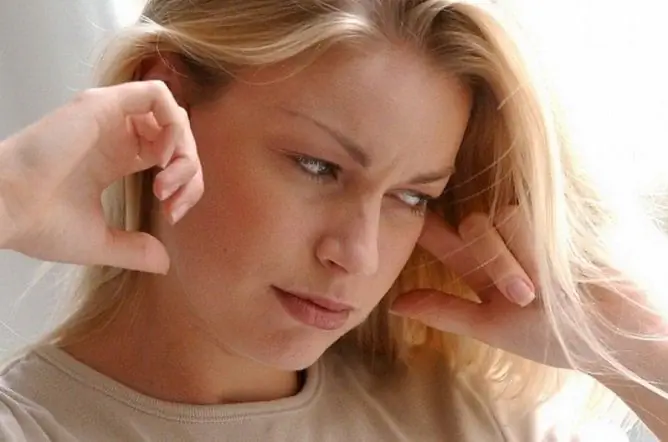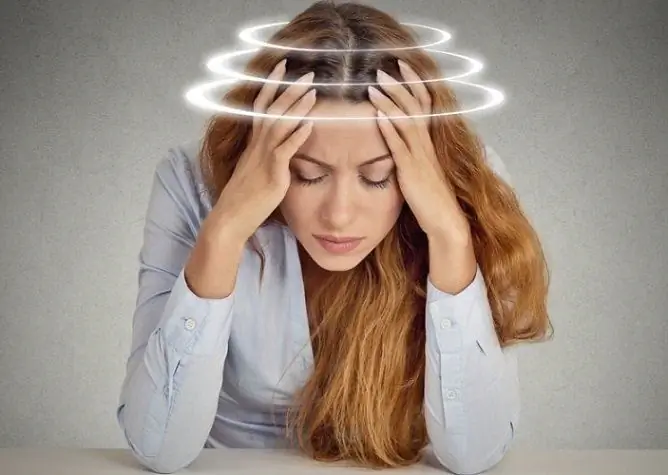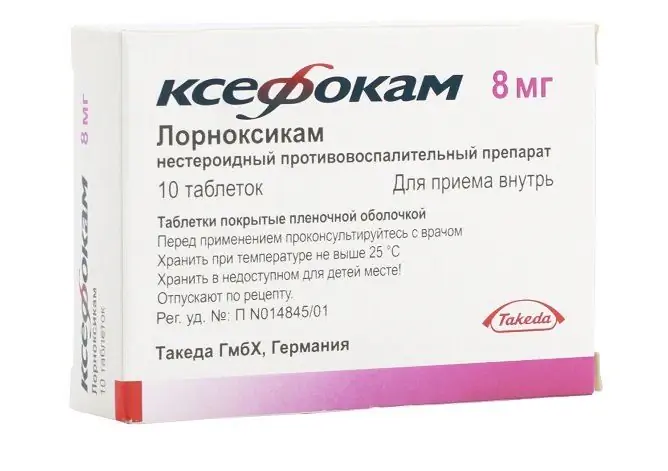- Author Rachel Wainwright [email protected].
- Public 2024-01-15 19:51.
- Last modified 2025-11-02 20:14.
Panic attacks with cervical osteochondrosis
The content of the article:
- Causes of occurrence
- Panic attack symptoms
-
Treatment of panic attacks with cervical osteochondrosis
Drug therapy
- Video
Panic attacks in cervical osteochondrosis are sudden attacks of gratuitous fear, anxiety, combined with various autonomic symptoms and resulting from compression of nerve endings and blood vessels in the neck. The cause of the disorders is degenerative processes in the intervertebral discs, leading to changes in the structure of the osteo-ligamentous apparatus of the cervical spine. Treatment is aimed at weakening the compression of blood vessels, nerves, getting rid of anxiety and relieving internal tension.

Panic attacks can be one of the manifestations of osteochondrosis
Causes of occurrence
A complex of degenerative disorders in articular cartilage, called osteochondrosis, most often affects the discs between the vertebrae. Depending on the localization of the pathological process, cervical, thoracic and lumbar osteochondrosis are distinguished. Deterioration of nutrition of cartilaginous tissues and vertebral bodies, local overloads of motor segments of the spine, imbalance in the patient's hormonal system lead to the fact that the cartilage loses its elasticity and strength.
As a result of changes in the consistency and shape of the cartilage, complications arise: protrusion and hernia of the intervertebral disc. The first is a bulging of the disc into the spinal canal without rupture of the annulus fibrosus, the second with a rupture. All this causes compression of the nerve roots and vertebral arteries, deterioration of the blood supply to the structures of the brain.
In addition to hernial protrusion, compression of nerve endings and blood vessels can be provoked by the mechanical effect of osteophytes. This is the name of the pathological bone growths that arise on the vertebrae with a violation of calcium metabolism in bone tissue. The impetus for their development is often deforming loads on the cervical spine.
Panic attack symptoms
Panic attack, which used to be often referred to as VSD (vegetative vascular dystonia) with a crisis course, sympathoadrenal crisis, can last from several minutes to hours. When it comes to cervical osteochondrosis and panic attacks, the latter usually last 10-15 minutes. In addition to panic, unexplained internal stress, they are characterized by a number of vegetative manifestations. To make a diagnosis, four or more of the following symptoms are required:
- cardiopalmus;
- excessive sweating;
- feeling short of breath;
- frequent shallow breathing;
- feeling of inner trembling;
- instability, uncertainty in determining their position in space;
- violation of the perception of the surrounding world, its unreality, remoteness;
- feeling of their actions as if from the outside;
- fear of committing an uncontrollable act;
- fear of death;
- confusion of the thought process;
- feeling of numbness, burning, tingling in the hands and feet;
- nausea, feeling of a lump in the throat;
- "Cold" in the stomach;
- pain in the abdomen;
- stool disturbance;
- frequent urge to urinate;
- impaired auditory and visual sensations;
- increase in temperature, pressure;
- convulsive contractions in the limbs.
Despite the long list of vegetative symptoms, the main characteristic features of the described condition are anxiety and fear. Their relationship with any special situation or complex of circumstances cannot be traced, but they often begin at a certain position of the patient's body: lying on his back in sleep, sitting with his head thrown back, etc. This is due to the increasing compression of blood vessels and nerves in the neck arising in this case.
Treatment of panic attacks with cervical osteochondrosis
Most of the therapeutic measures for panic attacks caused by degenerative processes of the cartilage tissue of the cervical spine are aimed at treating the underlying disease - osteochondrosis. The wellness program includes a whole range of methods.
| Healing method | Characteristic |
| Drug therapy | It is prescribed during the period of exacerbation of the disease to relieve symptoms, and in the stage of remission - to prevent the progression of the process and prevent complications. |
| Physiotherapy procedures |
Physical factors (ultrasound, laser, low-frequency currents, magnetic fields, etc.) make it possible to relieve pain and inflammation; improve blood circulation, regeneration processes; increase the effectiveness of medicines, make it possible to reduce their dosage; the use is not accompanied by the side effects inherent in drug treatment. |
| Physiotherapy | A method that allows, by creating certain dosed loads, to improve blood flow, metabolism and nutrition of cartilaginous tissue, increase the space between the vertebrae, strengthen the muscle corset, give the ligaments and muscles the necessary flexibility, and reduce the load on the spine. |
| Traction therapy | The traction procedure using special equipment and an individually selected load is aimed at expanding the space between the vertebrae, restoring the anatomically correct shape of the spinal column, and relieving pain. |
| Massage | Mechanical (rubbing, pressure, vibration) and reflex action on tissues, carried out by hands or special devices on the surface of the patient's body, to relieve pain, normalize metabolism, and stimulate the regeneration of cartilage tissue. |
| Acupuncture | The impact on the body is carried out by introducing special needles into certain biologically active points on the body. The main effect is to reduce pain. |
Drug therapy
Taking medications is aimed at weakening the compression of blood vessels and nerves and at eliminating anxiety, negative emotional mood. Depressive state in patients is associated with fear of attacks and their constant expectation.
| Pharmacological group | Drugs | Act |
| Non-steroidal anti-inflammatory drugs | Diclofenac, Nurofen, Naproxen, Nimesil, Indomethacin, Ketoprofen, Ibuprofen, Nobedolac, Meloxicam, Xefokam, Movalis | They have an analgesic, antipyretic, anti-inflammatory effect. They are used in various dosage forms: injections, tablets, capsules, suppositories, ointments, gels, sprays. |
| Muscle relaxants | Sirdalud, Midocalm, Baclofen, Baklosan | Reduce muscle tone, both in acute painful muscle spasm and in chronic spasticity of spinal and cerebral origin; increase the range of motion in the joints; facilitate exercise, manual therapy; have a moderately pronounced analgesic effect. |
| Chondroprotectors | Chondroitin, Chondroxide, Chondrolone, Teraflex, Rumalon, Artra, Alflutop | They slow down the degeneration of cartilage and contribute to the restoration of cartilage tissue: they enhance the biosynthesis of collagen, sulfated mucopolysaccharides, stimulate the regeneration of articular cartilage, reduce the activity of enzymes and inhibit the processes of destruction. |
| Vitamins |
Vitamin A (retinol); group B: B1 (thiamine), B2 (riboflavin), B6 (pyridoxine), B12 (cyanocobalamin); C (ascorbic acid); D (calciferol); E (tocopherol) |
They improve metabolic processes in cartilage tissue, promote the absorption of minerals, normalize nerve conduction, regeneration of cartilage and connective tissue, stimulate the active production of collagen, inhibit osteoporosis. |
| Minerals | Calcium, phosphorus, magnesium, manganese | They ensure the strength of the spine and its normal functioning: they form the basis of the mineral component of bone tissue, affect the contractility of muscles, and participate in metabolism. |
To correct the emotional background, sedatives and antidepressants are used. The first include medicinal substances of plant or synthetic origin, causing calming or relieving emotional stress without a sleeping pill (motherwort, valerian, mint, etc.).

Panic attacks with osteochondrosis are treated in combination with the underlying disease
Representatives of the second group are psychotropic drugs that eliminate the manifestations of depression. They improve mood, reduce or relieve lethargy, melancholy, apathy, anxiety. Selective serotonin reuptake inhibitors (paroxetine, fluoxetine, etc.) are considered first-line drugs. Only a specialist should prescribe such drugs.
Video
We offer for viewing a video on the topic of the article.

Anna Kozlova Medical journalist About the author
Education: Rostov State Medical University, specialty "General Medicine".
Found a mistake in the text? Select it and press Ctrl + Enter.






